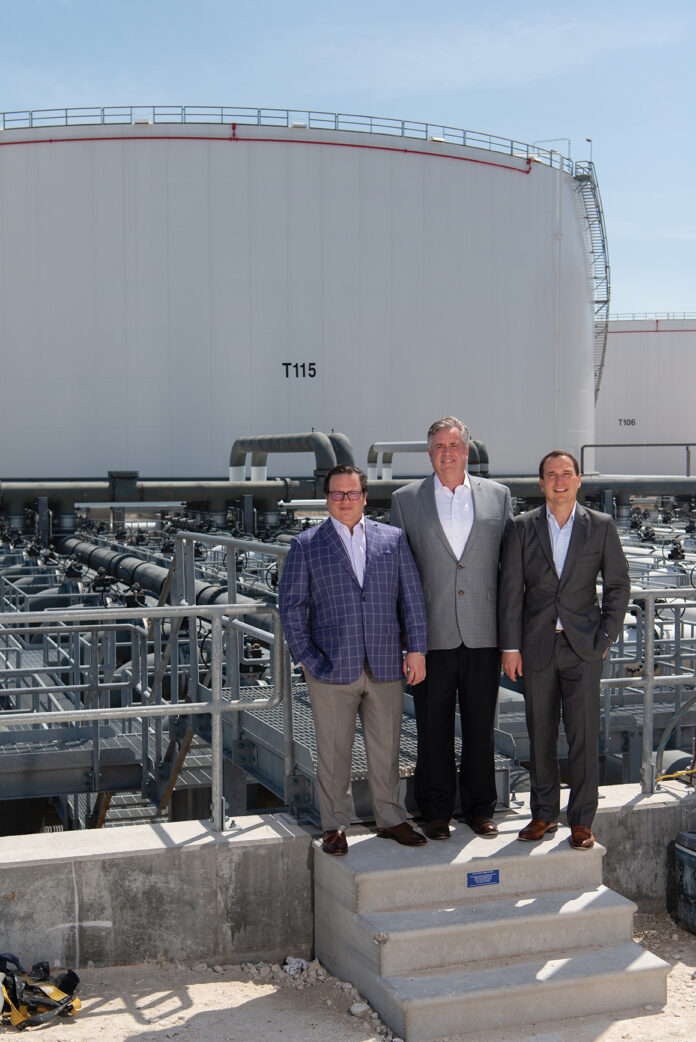
When, in December 2015, then-President Barack Obama affixed his signature to one of the many omnibus spending bills that congress has sent to various presidents over the last 15 years or so, few could have predicted the massive paradigm shift the act would have on America’s oil and natural gas industry. Few observers were unaware of the fact that Republican Senator Lisa Murkowski had succeeded in including an amendment to the bill containing language that created a literal sea change in the industry’s fortunes that would, in turn, result in a frenzy of development at the Port of Corpus Christi.
That language repealed an arcane relic of the horrific energy policies of the 1970s, one that banned the export of crude oil produced in the United States that had not first been refined in a domestic refinery. It was a sad and illogical leftover from the days of Arab oil embargoes and former President Jimmy Carter’s belief that the world would run out of oil in less than 20 years. Boy, was he surprised when the industry just kept on finding more and more oil to produce for the next half-century.
The industry itself had sought the change, lobbying Murkowski and other key members of congress as prodigious new volumes of light, sweet crude oil produced from the various big shale resources in Texas, Colorado and North Dakota poured onto the market, creating a rising imbalance between the supply of that grade of crude and the capacity of domestic refiners to process it at their facilities.
The fear in the industry was that the time was growing near when volumes produced in areas like the Eagle Ford, the Bakken or the Permian Basin would be unable to find a refining home, a situation that would likely result in a huge gap between domestic and international prices for crude and a necessary curtailment in U.S. drilling and fracking projects. President Obama, no friend of the oil and gas business, had repeatedly promised to veto any stand-alone bill containing Murkowski’s repeal language, but there were enough of his priorities contained in the omnibus spending bill to attract his approval.
Thus, the weird, sausage-making process of law creation in Washington, DC paid off for America’s oil and gas industry, and a rush to build out new infrastructure to transport light, sweet crude produced in the Permian and Eagle Ford plays to the Texas Gulf Coast in general, and the Port of Corpus Christ in particular, was on.
The Port of Corpus Christi – The Right Place at the Right Time
Even before the passage of the law, talk within the industry was that the opening-up of U.S. crude exports would create a rich growth opportunity for the Port of Corpus Christi (Port CC). The Port itself is situated less than 100 miles from the center of the Eagle Ford region in South Texas and is also the closest seaport to Midland. Home to an array of refinery operations, Port CC had long possessed the infrastructure to host a significant crude oil import operation and was already in the early stages of a major project in which the U.S. Army Corps of Engineers would deepen and widen the main channel to better accommodate more ships per day, including the larger classes of oil tanker ships.
Port CC had long been engaged in facilitating the limited volumes of crude oil exports from the U.S. that had always taken place. The 1970s-era law authorized the U.S. Commerce Department to issue permits to companies for the export of limited volumes of crude oil that had already been partially processed at well sites or central delivery facilities. Producers taking advantage of this permitting program as of December 2015 included Pioneer Natural Resources and ConocoPhillips.
Thus, Port CC had the location; it had the experience and strong leadership, and it had the promise of rapid future growth that would enable it to become the focal export hub for a national phenomenon that was destined to undergo an exponential growth pattern.
Over the first ten years of the 21st century, exports of U.S.-produced oil under the Commerce Department’s permitting program averaged well under 30,000 barrels of oil per day (bpd), in some months approaching zero. During the next five years, as the shale oil production booms in first the Eagle Ford and then the Permian Basin steadily grew, volumes exported under the program also rose, reaching more than 400,000 bpd at points in 2015. Once the repeal of the ban passed, volumes rocketed up in almost a vertical progression.

By February 2016, U.S. crude exports surpassed 500,000 bpd. By February 2017, just 12 months later, they topped 1 million bpd. In May of 2018, they topped the 2 million bpd mark and rose above 3 million bpd for the first time in June of 2019. By mid-2019, we at SHALE Magazine were quoting experts who contended that every incremental barrel of crude production in the U.S. from then-current levels would necessarily need to be exported because all available refinery capacity in the country had been spoken for.
Of course, at that point, U.S. production had just a few more months left to grow and peaked in November 2019. That was just before the global COVID-19 pandemic hit, throwing the industry into a tailspin that would last throughout 2020. According to the U.S. Energy Information Administration (EIA), domestic crude production dropped from 12.8 million bpd during November 2019 to just 9.9 million bpd in February 2021.
Shortly after the repeal of the export ban, the nation’s midstream industry embarked on a massive buildout of new infrastructure needed to carry the growing volumes of both oil and natural gas from West Texas through the Eagle Ford region and cross to the Gulf Coast. Companies like Kinder Morgan, Howard Energy Partners, Enterprise Products, Magellan Midstream, Enbridge and EPIC conducted the permitting and constriction of an unprecedented array of new capacity. Most of the natural gas and natural gas liquids capacity targeted endpoints at Mont Belvieu and the Houston Ship Channel, with most of the oil capacity not surprisingly targeting a final delivery point at Port CC.
Looking back, the industry is quite fortunate regarding the geographical location of these major shale formations because the simultaneous buildout of oil and gas infrastructure of such prodigious scope and scale could only have happened in Texas. Despite the rise of anti-development groups targeting many of the new pipelines, Texas policymakers at the state and local levels quickly comprehended the economic development potential this kind of infrastructure brings with it and worked to help clear the way for the various projects to come to fruition.
Within months, the media coverage of the situation regarding oil production shifted away from reporting about the previously-looming train wreck of over-supply meeting up with under-refining capacity. Now, the reporting centered upon a supposedly looming train wreck that would take place at Texas Gulf Coast ports when all of these new pipeline projects started flowing massive new volumes of crude oil to overwhelm their inadequate facilities. Again, the media was in for a big surprise, as it turned out that the ports and the import/export companies doing business within them were much more agile and creative than the reporters and the “experts” they like to quote had imagined.
Moda Midstream Enters the Picture
Wherever challenges related to the oil and gas industry exist, solutions tend to follow thanks to creative-minded entrepreneurs with access to capital and talent needed to make big projects work.
Ingleside, Texas, is a small community that lies directly north across Corpus Christi Bay from the main facilities of Port CC. The town long relied on Naval Station Ingleside as its main source of economic growth, but in 2005, the federal government’s Base Realignment and Closure Commission (BRAC) voted to shut it down as part of its ongoing military facilities streamlining efforts. On September 9, 2009, the USS Sentry was the last of the Minesweepers from NS Ingleside to arrive in its new homeport of Naval Base San Diego, the final ship to be home-ported at the base. On April 30, 2010, the base was formally shut down, and Port CC took over the property.
In 2012, OxyChem purchased most of the NS Ingleside property from Port CC for $82 million, with the rest being acquired by Flint Hills Refining for $8.5 million. OxyChem incorporated part of its acquired property into its pre-existing chemical plant operations located on the adjacent property.
In August 2018, the remainder of OxyChem’s property referred to as the Ingleside Energy Center was sold to a company called Moda Midstream, LLC. In the acquisition, Moda acquired a land footprint of 900 acres, which included liquefied petroleum gas storage, berths and infrastructure, certain crude oil pipeline assets and offsite logistics locations. In all, the company said it planned to invest between $300 million to $500 million to create a full-service, multi-functional storage and export terminal that would provide access to global markets for crude oil and LPG producers and marketers.
Incorporated in early 2015, Moda’s main source of initial funding was a commitment of up to $750 million in capital by Encap Flatrock Midstream, Encap Investments, management and co-investors. The company’s mission is clear and targeted: “To provide the superior logistics platform for our customers’ liquids handling needs through innovation and entrepreneurial effort, operational excellence and a safe and reliable environment for all our stakeholders.”
Armed with that large financial infusion, the company’s management team, led by co-founders CEO Bo McCall, Chief Operating Officer Javier Del Omo and Chief Financial Officer John Ackerman, quickly went about making deals for planned export infrastructure development.
• In March 2016, a little more than a year after its incorporation, Moda announced it would partner with Vopak, a large international terminal infrastructure company, to create Vopak Moda Houston (MH) to develop a marine terminal on Houston Ship Channel;
• In August of that year, Moda announced it would partner with Ergon to form Ergon Moda St. James, a brownfield crude terminal designed to serve one of America’s largest refining markets;
• Two years later, in August 2018, the company announced the acquisition of the Ingleside Energy Center (IEC), a storage terminal in nearby Taft, and other assets from OxyChem;
• By December, Moda announced it had already loaded its first VLCC at the newly-named Moda Ingleside Energy Center, or MIEC;
• In January of the next year, Moda announced its plans to help meet the growing demand for crude oil storage at Port CC by adding ten million barrels in crude oil storage to its pre-existing inventory, creating a facility with a total current capacity of 11.5 million barrels at the MIEC;
• By November 2019, the company had begun construction on a new expansion that will ultimately allow the MIEC to simultaneously service two VLCCs with a third loading facility capable of handling Suezmax ships, 900-ft. long vessels that can carry up to 1 million barrels of oil;
• The company currently has plans to add another 3.5 million barrels of storage, which will raise its total capacity to 15 million barrels.
If this pace of development at MIEC seems truly breathtaking to you, that’s only because it has been. But in reality, it has been executed just in time for the purposes of meeting the demands of the crude markets, as the major pipeline projects designed to carry Permian Basin and Eagle Ford Crude had completion dates along the same timeline.
MIEC services five of those big pipelines, accepting deliveries from the Cactus I and Cactus II Pipelines operated by Plains All American, the Gray Oak Pipeline operated by Phillips 66, Harvest Midstream’s Arrowhead Ingleside Pipeline and the EPIC Crude Oil Pipeline operated by EPIC Midstream. Moda also has future plans to accept deliveries from Phillips 66’s Red Oak pipeline.
Thus, the media narratives of 2017-18 questioning the ability of Texas ports to accept all of the millions of barrels of new light, sweet crude produced in the Permian and Eagle Ford shale regions died away as Moda and others worked with Port CC and other Texas ports to not just fill a looming void of capacity, but to put in place new, state of the art infrastructure that is capable of growing into the future. The question of whether these new volumes of crude would be able to find a refining home disappeared from view. For barrels seeking a home for export, the only question today is which of multiple facilities to access, and the MIEC has become the premier choice for many.
An Inland Port With Many Advantages
Even with its Channel Improvement Project, or CIP, with the Corps of Engineers underway, it was understood that one significant potential fly in the ointment remained to be resolved: The inability to fully load Very Large Crude Carriers, or VLCCs, the largest class of crude tankers, at facilities along Port CC’s main channel. The Port has historically been able to land these huge, 1,100 ft.-long beasts, which sport a capacity of up to 2 million barrels of oil, but has only been able to partially load them while in port, with the remainder having to be lightered via smaller vessels to them once they reach deeper waters in the Gulf of Mexico.
The channel improvement project will deepen the channel from its current depth of 47 ft. to 54 ft., but VLCCs require a minimum depth of 66 ft. when fully loaded, meaning they would still require some lightering after being partially loaded while in port. Recognizing this reality, Port CC officials have themselves worked on various potential solutions, including a project involving its nearby property at Harbor Island, which remains under consideration. Last year, Port CC entered into an agreement with Phillips 66 and Trafigura to build a VLCC-capable loading terminal in deep water 21 miles out into the Gulf of Mexico as a means of partially satisfying this need, and for now, the ability to fully load VLCCs at ports in Texas and Louisiana will be limited to this kind of offshore terminal.
But that doesn’t make the in-port facilities any less attractive, and their advantages are numerous, both for their customers and for the environment. Once the CIP is completed, Port CC will sport the deepest inland channel along the Gulf Coast, and Moda says it will be able to load an additional 20-35% of volume onto the VLCC/Suezmax class vessels, thus minimizing the need for lightering to get them fully loaded. MIEC boasts the Gulf Coast’s fastest loading rates, with a combined rate of 160,000 barrels per hour across its berths, making it able to turn around even the largest ships in less than 24 hours.
In fact, as Moda told us when we talked with them, the location itself is perfectly situated for a shipping operation, which was why the U.S. Navy selected it for its base to begin with. Established via the Defense Authorization Act of 1987 to accommodate a full naval battle group, Naval Station Ingleside was formally opened in 1992 when the USS Scout sailed into port to become the first ship formally based there. A reallocation of Naval resources ultimately led the Navy to make NS Ingleside its base for the Navy’s Mine Warfare Force, composed of Avenger-class mine countermeasures ships, Osprey-class coastal minehunters, and the command and control ship USS Inchon.
The location was originally favored for its safe harbor, its ability to berth multiple large vessels simultaneously and its proximity to open water. Situated adjacent to Port CC’s main ship channel and the Intracoastal Waterway, departing ships are just a handful of miles and minutes away from entry into the Gulf of Mexico. All of these characteristics are highly sought after when developing marine terminals, and, when considered alongside the asset’s proximity to resilient supply basins and next-generation pipelines, the facility was a natural fit for Moda’s portfolio.
Altogether, Moda’s facility has daily access to up to 3 million barrels of crude oil supply. The resilience of this massive supply chain is reflected in the MIEC’s performance. In 2020, MIEC solidified its position as the leading crude export facility for Permian and Eagle Ford grades of crude, proven out by its robust export figures. For the year, MIEC handled four times as many long-haul/large vessel loadings as the next closest location. In doing so, Moda facilitated customers’ access to international markets during a time of crisis in the industry.
In addition to all of its already installed capacity, the MIEC property still contains 925 unused acres available for further expansion of its infrastructure and capabilities. Thus, as the U.S. industry enters cautiously into another boom time, MIEC has plenty of room to grow should the level of supply demand it.
Another advantage to loading and off-loading crude inland rather than out in the federal waters of the Gulf of Mexico has to do with the protection of the environment. As Sean Strawbridge, the CEO of Port CC, has pointed out many times, inland terminal operators must meet the requirements of both federal and state emissions regulations, thus providing a higher level of protection, and Port CC maintains its own high standards. At the MIEC, Moda goes the extra mile to not only meet but exceed these regulatory requirements.
“We are committed to building a sustainable, reliable business that incorporates best practices in everything we do. Moda has been a leader in environmental stewardship,” Moda told us in an email. “Although we are a private company, we just published our second annual Sustainability Report and made it available on our website to share our approach and actions with stakeholders.
“As detailed in our Sustainability Report, we strive for Lowest Achievable Emission Rate (LAER) equivalent emissions control technology, even when less-stringent Best Available Control Technology (BACT) is the requirement. For example, when Moda purchased the Ingleside Energy Center facility in 2018, we voluntarily upgraded the controls of tanks that were under construction by upgrading the seals, slotted guide poles, columns and leg socks.
“Furthermore, through engineering and thoughtful design, we have reduced Volatile Organic Compound (VOC) intensity by more than 70% at MIEC while tripling throughput and increasing storage capacity. Most recently, we launched an air monitoring pilot program to further enhance our ability to manage our environmental footprint.”
Moda also places a high priority on safety measures at the MIEC. “At Moda, we put safety first and strive to do the right thing every time,” the company said. “We foster a culture of safety excellence based on a shared sense of ownership and vigilance by every member of our team. Our safety programs are designed to help prevent incidents from occurring, but we also proactively prepare to respond effectively to any emergency that might occur. We maintain comprehensive Facility Response Plans and have worked to ensure our designs exceed National Fire Protection Association and industry standards.
“The integrity of our maritime operations is paramount. For example, at Moda Ingleside Energy Center, our liquid and vapor marine infrastructure incorporates loading arms equipped with state-of-the-art emergency release couplings (ERC) to safely and efficiently load vessels in a controlled environment. The advanced infrastructure allows for the vessel and shore facilities to separate without releasing any product in the event of an unexpected upset. In addition to environmentally conscious ERC equipment, we deploy a spill containment boom around all vessels while berthed at our facility, providing an additional level of safety and redundancy. We have also taken steps to ensure that tugboat equipment is available to ensure vessel stability, monitor traffic proximate to MIEC, provide immediate emergency response and help safe transit to open waters.”
The ongoing need for lightering notwithstanding, even the biggest crude carriers benefit by bringing their cargoes inland.
A Sea Change in America’s Energy Security
America did not become fully energy independent during the Trump presidency, but its level of energy security was greatly enhanced by the massive increase in oil production from the prodigious shale resource plays in Texas and other parts of the country. Prior to the election of Joe Biden, this new energy security had driven gasoline prices to 30-year lows and relieved the U.S. from any real need to rely on the Middle East to help meet its daily demand for crude oil. That’s all being reversed now but will forever remain a fact of history.
The story of the just-in-time development of the infrastructure and services needed to facilitate the movement of all that new crude to markets not just in the U.S. but internationally is only just now beginning to be told. It is a classic American story of smart entrepreneurs identifying a future area of demand and moving quickly to be able to meet it when it materialized.
It’s been a massive paradigm shift, and changes like this don’t just happen: They require an intense level of focused effort over extended periods of time. A prime location had to be identified, and NS Ingleside was there and available. Capital had to be raised, and Encap was there and willing. Existing infrastructure had to be improved and new facilities built out. Contracts with multiple major pipeline projects had to be negotiated and finalized. The Taft hub site, which helps manage movement of the supply from multiple pipelines, had to be acquired and constructed. Logistics and safety and environmental protection plans had to be developed and finalized. And all of it had to be ready to flow oil and load ships just in time, as the oil started to arrive from West Texas through the pipelines.
Fortunately for Texas and the country, the team at Moda Midstream proved more than capable of handling all of that related to the MIEC while developing multiple other facilities at the Ports of Houston and St. James at the same time. Port CC today is far and away America’s most important hub for the export of U.S.-produced crude oil, and the MIEC is a vital centerpiece of the massive level of economic growth that it produces.
When Barack Obama signed that omnibus spending bill in December 2015, he could have never envisioned that it would lead to all of this and play such a vital role in facilitating such a sea change in America’s level of energy security. The pace and scale of the paradigm shift in such a short period of time have been truly stunning. The team at Moda Midstream played an indispensable role in making it all happen, and as we have seen, has the capacity to expand that role well into the future.
About the author: David Blackmon is the Editor of SHALE Oil & Gas Business Magazine. He previously spent 37 years in the oil and natural gas industry in a variety of roles — the last 22 years engaging in public policy issues at the state and national levels. Contact David Blackmon at [email protected].














